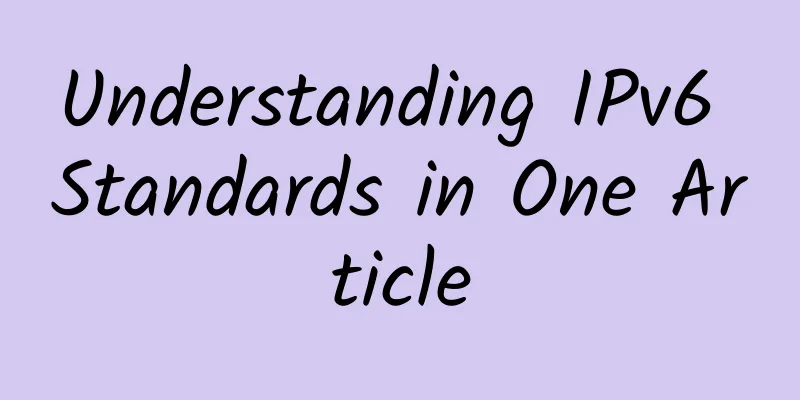Understanding IPv6 Standards in One Article

|
The IPv6 standard is mainly divided into five categories, namely resource category, network category, application category, security category, and transition category. See Figure 1 for details. Resource standards are the core standards that distinguish IPv6 from IPv4, mainly including addressing technology standards and domain name technology standards. Network standards are standards related to IPv6 network layer technology, mainly including routing technology standards and mobile IPv6 standards. Application standards are the standard specifications that need to be followed when IPv6 technology is applied to mobile Internet, Internet of Things and other applications. Transition standards are the technical standards involved in the transition process from IPv4 to IPv6. Among various standards, resource, network, security and transition standards are mainly studied and formulated in IETF. BBF (Broadband Forum) is also formulating IPv4/v6 network transition standards involving access aggregation networks; mobile Internet standards are mainly formulated in 3GPP; standards involving IPv6 applications in the Internet of Things are currently mainly formulated in IETF and IPSO (IP for Smart Objects) Alliance; ITU-T mainly formulates IPv6 standards related to NGN. International Standards IETF is the main body of international IPv6 standardization. Since 1995, IETF has formulated more than 200 IPv6-related RFC standards. The core IPv6 standard has been completed. The current work is mainly focused on the transition from IPv4 to IPv6, as well as supplementing and improving the existing IPv6 standards. In addition to IETF, other international organizations, such as 3GPP, 3GPP2, ITU-T, etc., have also formulated some IPv6 application standards. Resource Standards 1. Addressing standards IETF has completed the standardization work on technologies such as IPv6 basic protocol, address structure, neighbor discovery mechanism, and address allocation mechanism, and has released 118 related RFCs. This type of standard is basically complete, and the current focus of standardization work in this field is on the maintenance and supplementation of the original protocol standards. 2. Domain Name Standards IETF has basically completed the standardization work on DNS extension to support IPv6 and has released 11 related RFCs. This type of standard is basically complete. The current focus of standardization work in this field is on the maintenance and supplementation of the original protocol standards. Network standards 1. Routing standards Corresponding to the IPv4 routing protocol, IETF has completed the formulation of routing protocol standards for IPv6 networks, and released 29 RFC standards including RIP, OSPF, BGP, IS-IS and other routing protocols, multi-homing technology and IPv6 MPLS VPN. This type of standard has been perfected, and the routing protocols used in the existing IPv4 network basically have corresponding IPv6 versions. IETF is currently researching and developing the next generation of routing mechanism standards. During the development process, IP version compatibility has been taken into consideration for such standards, and they can be directly applied to IPv6 networks. 2. Mobile IPv6 Standards IETF has completed the main standards for mobile IPv6 architecture, protocol, fast switching, and released 35 related RFCs. This type of standard is basically complete, and the current research focus of IETF is to optimize the performance of mobile IPv6. Application Standards 1. Mobile Internet In terms of 3GPP, the standards related to IPv6 have been basically completed, and the main standards are TS 24.303/TS 29.275/TS 29.282. Once the 3GPP standards involve interaction with IETF, 3GPP will put forward the corresponding requirements, send a contact letter to IETF, and then IETF will complete it. In 3GPP, the main projects that interact with IETF are IMS-related and SAE-related standards. In terms of mobile network transition, China Mobile established a new research project in 3GPP SA2 in May 2009, named "Study on IPv6 Migration" with the project number TR 23.975. The main research is on how IPv4 networks evolve to IPv6 networks, including evolution scenarios, solutions, impact on network elements, impact on compatibility and interoperability, etc. The project application has just been approved and no manuscript has been input yet. 2. Internet of Things IETF currently has three working groups (6lowpan, Roll and Core) involved in standardization work in this field, and has released three formal RFCs covering requirements, scenario descriptions and bearer methods, etc. The IPSO Industry Alliance was established in September 2008, mainly focusing on the application of IPv6 technology in the networking of smart objects and playing a role in industry coordination. At present, IPSO has released four white papers covering framework, address, neighbor discovery, protocol stack requirements, etc. The alliance will mainly work based on the results of IETF's 6lowpan and Roll working groups. Overall, although the standards for the Internet of Things involving IPv6 are still in the early stages of drafting, they are developing rapidly, and the relevant standard groups and industry alliances are relatively active. 3.NGN ITU-T has completed four standard recommendations: IPv6-based NGN, IPv6 multi-homing framework in NGN, IPv4/v6 evolution functional requirements and signaling framework in IPv6-based NGN. ITU-T is currently studying and promoting a number of projects, including vertical multi-homing in IPv6-based NGN, ID/Locator separation framework in IPv6-based NGN, network access function requirements in IPv6-based NGN, and IPv6 evolution roadmap for NGN operators. Safety standards IPv6 security mechanism and security standard system have not changed significantly compared with IPv4. The original standards related to IPSec are basically applicable to IPv6, and the maturity of IPv6 security standards is basically the same as that of IPv4. The SAVI working group in IETF, which was promoted by Tsinghua University, is currently studying and formulating a network security mechanism based on source address verification, which is also applicable to IPv6 networks. Transitional Standards The transition technologies from IPv4 to IPv6 are mainly divided into dual stack, tunnel and translation technologies. 1. Dual stack technology For dual-stack technology, the device or terminal only needs to support IPv4 and IPv6 protocol stacks respectively and follow the corresponding standards. 2. Tunnel technology For tunnel technology, IETF has developed a number of tunnel technology standards, including manual tunnel, GRE tunnel, tunnel proxy, 6to4 tunnel, 6over4 tunnel, ISATAP tunnel and TEREDO tunnel. The current hot spot is the standardization research of softwire technology in the Softwire working group. Tsinghua University has submitted multiple drafts to the working group and two of them have become RFC standards. 3. Translation Technology Regarding translation technology, the current research focus of IETF is on translation technology standards that support IPv6 and research on large-scale NAT technology. Although there are already a variety of alternative technical solutions (such as CGN (carrier-grade NAT) technology and IVI technology, etc.), these technologies themselves are not yet mature and have not been verified by large-scale network applications. in conclusion In general, in terms of IPv6 international standards, the current network layer standards are mainly formulated by IETF. The core standards are mature and can basically meet the needs of pure IPv6 networking, but the transition standards are not yet fully mature. Among the application standards, the standards corresponding to traditional telecommunications services (such as NGN, soft switching, mobile, etc.) are undertaken by the corresponding standards organizations, with different progress. Some Internet services (such as Web 2.0, etc.) are not related to the underlying bearer protocol and do not require the support of standards. In terms of specific standard categories, resource and network protocol standards are relatively complete and can basically meet the needs of pure IPv6 networking; security standards are still immature in terms of network security and trustworthiness; in interoperability standards, dual stack and tunnel technology standards are relatively complete, but the standards for IPv4/IPv6 translation mechanisms are immature. In the application standards, in terms of mobile Internet application standards, in 3GPP, the standards related to IPv6 have been basically completed, but the research on the standards for IPv4/v6 transition has just started and is not yet mature; the standards for the Internet of Things involving IPv6 are still in the early stages of drafting, but are developing rapidly. Conclusion Judging from the current status of IPv6 standardization work at home and abroad, the main problems in IPv6 standards include: 1. Transition standards are immature This is mainly reflected in the address translation mechanism. Currently, there are no mature technical standards either domestically or internationally, which makes it difficult to meet the needs of IPv4/v6 network interoperability. 2. Application standards are immature The IPv6-related standards currently formulated internationally and domestically are mainly focused on network carrying. There are relatively few standards in application areas such as mobile Internet and the Internet of Things, and the standard system is not yet fully mature. Therefore, the country should seize this opportunity, fully rely on the current domestic CNGI network environment, combine the existing standards, and focus on these two aspects to study and formulate IPv6 standards with innovative content and Chinese characteristics. At the same time, it should actively participate in international cooperation and strive to influence the formulation of international standards with domestic standards, thereby gradually strengthening my country's voice in the formulation of international standards. |
>>: IPv6 series - 10 common problems for beginners
Recommend
Knowledge points of wireless network coverage system
1. What is AP? Answer: AP - Wireless Access Point...
5G market is rapidly expanding and artificial intelligence scenarios are becoming a reality
[[183832]] In response to the explosive growth of...
How to Choose the Right Data Cabling for Your Business
Are you building a new office? Is your current of...
Uncover the mysterious navigation behind the Internet, DNS domain name resolution
In the vast information system of the Internet, D...
Seven common misconceptions about the 802.11ax wireless LAN standard
For the 802.11ax wireless LAN standard, which is ...
5G is here. Join hands with the industry to welcome 5G large-scale commercial use
[Shenzhen, China, April 17, 2019] "5G is dev...
Yunfan Accelerator's Chen Hui talks about how the revenue of new media in radio and television can outperform the cost
On May 17-18, the 2017 Asia-Pacific OTT/IPTV Ecos...
It's no big deal for the three major operators to withdraw from the US
After several twists and turns, China's three...
Website built by Alibaba Cloud, fool-proof way to prohibit foreign IP access
1. Introduction The solution is suitable for tech...
How much do you know about the development of Wi-Fi?
As someone who uses Wi-Fi every day, have you eve...
What is optical networking? Full explanation
Optical networking is a technology that uses ligh...
Watch Process Little P tell its network performance story!
[[394922]] This article is reprinted from the WeC...
RackNerd's 3 KVM promotions in April start at $13.89 per year, with multiple computer rooms available
RackNerd has released its April promotional packa...
2022 F5 Multi-Cloud Application Service Technology Summit was grandly held, embracing open source, embracing localization, and embracing digital innovation
April 20, 2022 – The 2022 F5 Multi-Cloud Applicat...
Will 5G eliminate Wi-Fi/4G? No, multi-access network integration is the way to go!
The advent of 5G brings not only new technologies...









